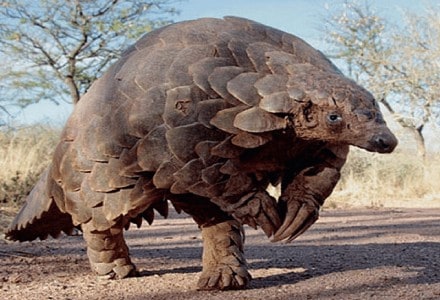
Pangolin Facts
- Most notably, the incredible Pangolin remains the only known mammal to have evolved protective scales. Due to the presence of these, people sometimes call it the scaly anteater.
- The animal also constitutes the only surviving member of a family. In addition, only four known species of this unique creature exist.
- Sadly, this impressive species now lists as Critically Endangered with the IUCN. This occurs partly for a very sad reason. That’s because the Pangolin remains the most heavily hunted mammal in the world.
- However, the amazing creature now enjoys protection under the law. But, illegal hunting continues. It still gets hunted both as a source of bushmeat and for its scales, which get used in making clothing.
- Finally, the animal also gets hunted for use in making traditional medicines.
Related Articles
Bandicoot Viscacha Raccoon Dog
Public Domain Image
Pangolin Physical Description
Due to its rather distinctive appearance, the Pangolin remains easily recognizable. In recent times, it has even become something of a media sensation. This occurs due to the coincidental evolution of a unique visage.
Additionally, the scales covering its body grow large in relation to body size. Furthermore, these are composed of keratin. Each scale also possesses a sharp edge, further increasing the protection they provide.
As a result of their nature, these scales serve to protect the Pangolin from most of its would-be predators. Further, the animal curls into a tight ball when threatened, presenting these to the attacker.
The various species range in length from 12-39 in (30-100 cm). Average weight is about 4.4 lb (2 kg). Sexual dimorphism is present, with males averaging 50% larger than females.
The legs grow short, giving it a low-slung form. It also possesses a thin tongue which the animal can extend as much as 16 in (40 cm).
The claws are relatively long and quite powerful. In addition to its armor, it also has a second defense mechanism. When threatened, it can release a noxious-smelling chemical from glands near the base of its tail.
- Kingdom: Animalia
- Phylum: Chordata
- Class: Mammalia
- Order: Pholidota
- Family: Manidae
Pangolin Distribution, Habitat, and Ecology
First of all, the amazing Pangolin evolved as endemic to a specific habaitat range. This mainly consists of certain parts of both Asia and Africa. It also inhabits either grasslands or forests within that range.
The majority of the different species live as nocturnal, yet one appears active by day. It typically makes its homes in either hollow trees or deep burrows. These burrows may be as much as 11 ft (3.5 m) deep.
Its diet consists mainly of termites and ants, which it locates with its keen sense of smell. These it extracts with its specially adapted tongues.
This extraordinary creature typically walks on all four legs, yet remains capable of walking on its rear legs only for a short time. It also seems to be an excellent swimmer.
This animal lives a primarily solitary life, usually meeting only to mate. A typical litter contains 1-3 offspring.
Species Sharing Its Range
Scythian Lamb Phyllium Siccifolium King Cobra
Check out our other articles on Asian Palm Civet, Vervet Monkey, Draco Volans, Sensational Spiders Around the World, Chatham Island forget-me-not, Black Rain Frog

